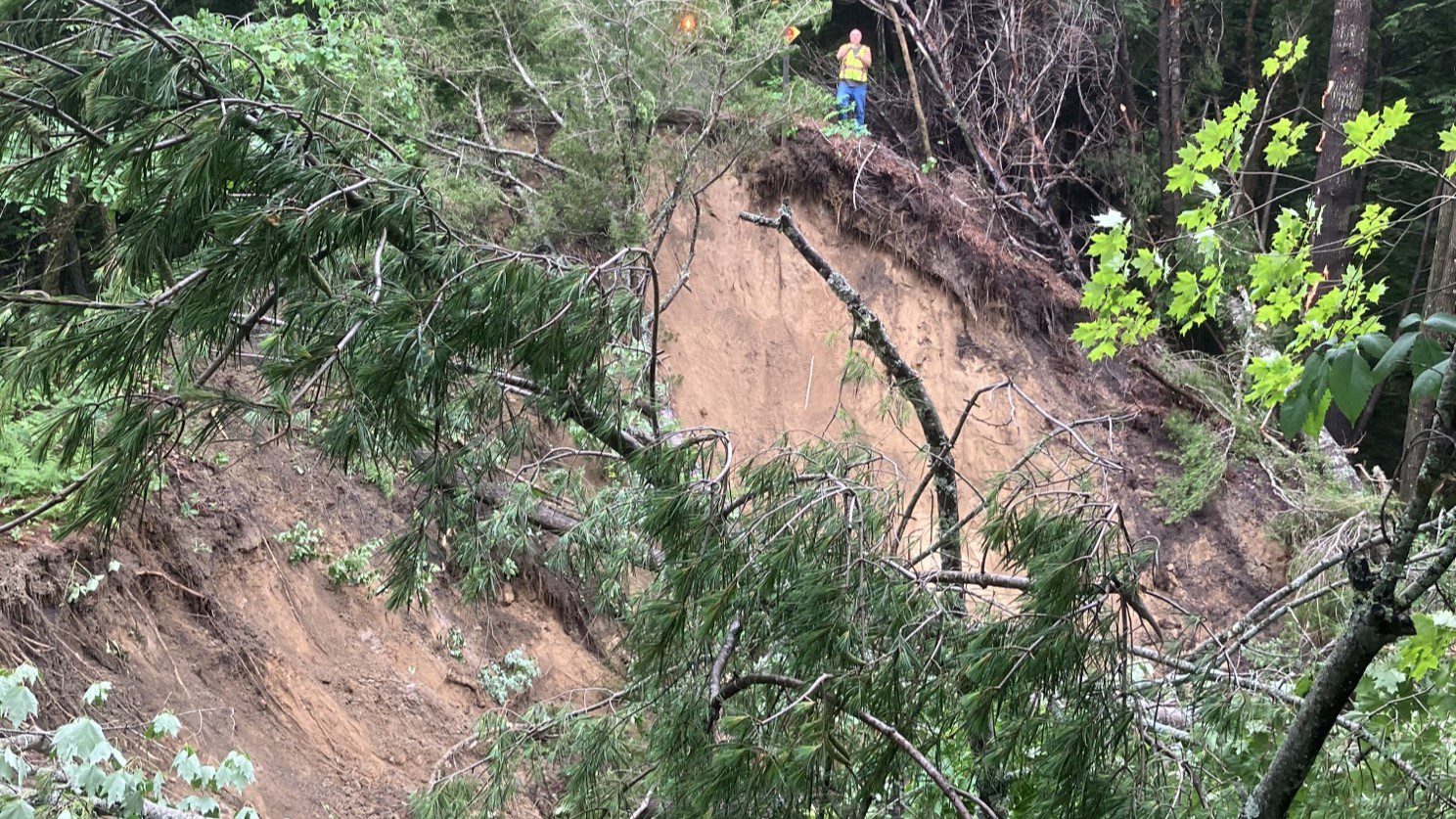After a summer of frequent downpours and intense flooding, state officials and some of Maine’s hardest-hit ATV clubs are wondering how they will restore their rain-battered trails for next year and the years to come.
Their concerns arise from the hefty price of trail maintenance projects and the waning ATV club volunteerism that groups rely on to keep their trail systems safe and functional.
Maine’s patchwork of roughly 6,000 miles of ATV and multiuse trails rests on the back of dozens of these ATV clubs, who finance their trail systems’ maintenance with donations and state grants.
This year’s precipitation and damages means their work is cut out for them.
Erosion, consistent inundation and seasonal maintenance projects contributed to the closure of up to 600 miles of ATV and multiuse trails before September, according to Brian Bronson, supervisor of the state’s Off Road Recreational Vehicle Program.
With 36 years of experience, Bronson said this year’s conditions are the worst he’s seen.
“Just the other day I said, ‘I’m a really old man because I’ve lived through three 100-year floods this summer. So I got an excess of 300 years,’ ” Bronson said. “Obviously these storms are just incredible.”
The season got off to a rocky start when the Maine Department of Agriculture, Conservation and Forestry issued a notice in May that trails should stay closed until Memorial Day weekend due to spring flooding.
More rain followed in June, with heavy flash flooding wiping out a portion of the popular Whistle Stop Trail in Jay that left washouts around 50 feet deep.
Bronson said Wednesday that he anticipates the repairs to cost around $800,000 for Whistle Stop alone, and around $1.2 million for other storm-related damages to trails statewide.
“We’ve never had to deal with anything like this before,” Bronson said. “And this is so extreme that we currently don’t have the funding.”
The state’s off-road trails program, which receives funding from ATV registration revenue, was allotted $3.5 million in last year’s budget that ended in June, according to Bronson.
In Rumford, the summer deluge forced the Rumford Riders ATV Club to close its 47-mile trail system for the season in late August, weeks before most trails close.
Franklin County ATV clubs have faced similar challenges, with some watching maintenance projects wash away before getting a chance to ride them.
Mike Young, trail manager for the Kingfield Quadrunners, said his club had to close its trail system for July because the trails were so wet they were worthless.
“It’s been a terrible year for four-wheeling up here,” Young said.
According to data from the National Weather Service, Kingfield received 9.5 inches of rain in June — almost five inches more than the monthly average between 2000 and 2023.
Young added that when club members tried to repair a trail, spending thousands of dollars and hauling out hundreds of yards of gravel to fix mud holes and shore up the trail bed, their progress got washed away by August rains.
“(The work) was a losing battle,” Young said. “Money, time and labor, and nothing to show for it.”
Most of that labor rests on a few members. Of the 70 members of the Kingfield Quadrunners, Young said around eight or nine are the only ones contributing to maintenance projects.
He said he understands that some members have heavy work schedules or live out of state, but if it weren’t for that core group, things would be more difficult. Looking to next year, Young said the only thing his club can do is hope normal weather will allow for repairs.
“This year has just been impossible. Soft spots turn into jelly, and even powerful machines are having trouble,” he said.
Up the road in Eustis, the Flagstaff Area ATV Club also had a trail season dashed by rain and mud.
Sandi Isgro, the club’s vice president, said they spent lots of time and money last fall to get ready for this season, only to see their efforts washed away by a summer rainstorm.
“Basically all the work that we did in the fall the previous year to get ready for the new year just washed away,” Isgro said.
Of the club’s 133 miles of trails, Isgro said 80 miles were closed, many due to water damage. Attempts to make repairs this year have been an uphill battle.
“(We) couldn’t catch a break,” Isgro said. “As soon as (we) fixed one trail and got that back up and running, then we’d have another rainstorm. And another trail would have big huge washouts and mud holes and stuff like that. Now we do want some mud, we want people to have fun, but not that much fun.”
Aside from the weather, Isgro said the Flagstaff club also faced closures from landowners whose land the club’s trails lie on.
About 80% of the state’s ATV trails are on private lands, according to the Maine Department of Agriculture, Conservation and Forestry — requiring strong relationships between landowners, clubs and other riders.
When landowners withdraw their permission, clubs like Flagstaff can lose chunks of trail, causing a dip in donations and dues.
Isgro said when her club lost a large loop that circumnavigated much of Franklin County, ridership and donations went along with it.
“That (loop) brought a lot of people,” Isgro said. “A lot of people brought a lot of money, and they would donate to the clubs. This year we haven’t seen that because we haven’t been getting all that ridership anymore.”
Add that to a small pool of volunteers, and the club’s challenges only grow.
“We don’t have enough volunteers to run everything,” Isgro said.
The Flagstaff ATV Club also has had the same club leaders for seven years, and Isgro worries about who will take over if young ATVers don’t step up.
“They have to like the sport,” Isgro said. “If you want the sport to say, then you’re gonna have to help … or we’re going to lose everything.”
John Raymond, president of the statewide ATV advocacy group ATV Maine, mirrored some of Isgro’s concerns. He said only about 16% of ATV registrants in Maine are club members, yet they serve as the backbone of the trails the other 84% ride.
Just over 80,000 people registered ATVs in Maine last year, according to Bronson.
Raymond said ATV Maine hopes to introduce a bill in the legislature next session that would require non-club members to pay $30 extra for their annual registration, while in-state club members would continue paying the current $71 that the state increased from $45 in 2022.
“If you don’t enroll with a club, you’re going to have to pay a little bit more because you’re going to have to help,” Raymond said.
He also categorized this year’s trail damage as the worst he’s seen. Raymond encouraged clubs to adhere to Maine’s best management practices for ATV trails, a statewide guide for building proper trails, to keep them sustainable.
“Normally we don’t have this many trail closures at this time of year. Once we get into a drier season, it’s not an issue,” Raymond said. “It’s been a tough year, and that’s another case: When you build your trails correctly, you should have the least problems with them.”
In Washington County, Down East Trail Riders ATV Club has been largely spared this year because of the effort the club put in to strengthen its trails, according to club trail manager Scott Ackley.
“We’ve been doing a lot of pre-emptive work for the last three, four years on our trails. We’ve put in a lot of culverts and we’re diverting the water before we have a problem,” Ackley said.
But like other clubs, Ackley said his club has had issues with volunteerism and aging leadership. At age 45, Ackley said he’s the youngest of the leadership, who are mostly in their 60s.
“It really does kind of suck because a lot of people say, ‘I will help,’ but when it comes down to it … people have other plans,” Ackley said.
John Daigle, a professor of forest recreation management at the University of Maine, has researched public recreation access on private lands.
He said Maine’s unique recreation structure, where public trails pass through private land, requires special attention from outdoor recreationists to take care of the trails and maintain access from landowners.
Although most landowners respect the traditions of public access, Daigle said, some could be quick to pull away that permission if trails turn muddy and start leaking sediment into critical habitat, like mountain streams.
It becomes more difficult to ensure that doesn’t happen, Daigle said, when factoring in climate change models that project more frequent heavy precipitation events.
A study published this year by Dartmouth University researchers projects that precipitation events of at least 1.5 inches will increase 52% by the end of the century in the Northeast.
“But again, if there’s conditions that are happening that (private landowners) are seeing that look really bad, they don’t have to provide access,” Daigle said. “Outdoor recreationists need to be aware of it, in terms of taking care of the land where they’re recreating so they can maintain access.”
Bronson, the off-road vehicle program supervisor, said Maine’s 6,000 miles of trails may need more careful management, where clubs and the state prioritize more essential trails — like those that connect towns and regions — over smaller, duplicative trails that only a few people ride on.
Maine had just 2,000 miles of trails in the early 2000s. A task force assembled in 2003 recommended increasing that number to 7,000 miles to accommodate increased ridership, according to a report from a 2019 ATV task force published in 2020.
“You don’t want everybody on one trail system,” Bronson said. “But if you have four different routes between two towns, you’re going to have to give up some of those trails — the funding just isn’t there.”
Though he hasn’t seen data on ATV registrations for 2023, he suspects it will be below last year’s 80,000-plus registrations due to this year’s weather and the 2022 fee increase — which means less funding for trail repairs.
He said increasing registration fees further would probably hurt revenue more than it would help, because ATVers would be less inclined to register multiple machines and instead consolidate to single, larger machines like side-by-sides.
Instead, the state and clubs will have to think more carefully about Maine’s complex ATV trail system and how to maintain it into the future.
“Big picture, we still want to expand in some locations,” Bronson said, “but we need to make good choices.”







